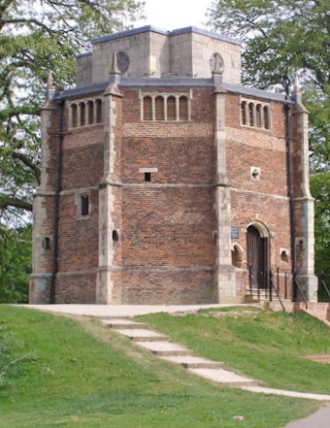The Norfolk town of King’s Lynn (formerly Bishop’s Lynn) is a lovely, atmospheric place to stroll around, with its rich medieval heritage – the town had a Hanseatic colony of Baltic traders, and the medieval wharves and lanes can still be seen. It was also the home of Margery Kempe, the fifteenth-century mystic and controversialist whose fascinating Book is one of the earliest examples of women’s literary culture in the English language.
The fifteenth-century Red Mount Chapel or ‘Chapel of Our Lady’, at King’s Lynn has often been overlooked or disregarded, but seems to me to be an aesthetic idea of Calvary. Building work started on it in 1482 and was finished by 1485, with the Chapel being dedicated to the Virgin. The building is octagonal, and as the pictures show, comprised over three levels: a spiral of rooms placed on top of each other. It is built on an artificial mound, just by the town’s wall, between two gates. It would have originally occupied a rural position, outside the town, and indeed it still stands in a green, tranquil space, in a park.
The Red Mount Chapel seems too to embody a Passion narrative: located on a mount outside the city walls (like Calvary), and polygonal (like the ‘round’ anastasis at Jerusalem), entered through the basement to a tomb, after which one ascended to a chapel of the Virgin. The polygonal form and the walled setting recall the two basic images of Jerusalem one sees in medieval depictions of Jerusalem. The location accords with the description of Calvary read out of the Gospels, a hill-cum-garden (John19:41) outside the city walls (Hebrews 13:12), ‘the whole valley of dead bodies and of ashes, and all the country of death, even to the torrent Cedron, and the corner of the horse gate towards the east’ (Jeremias 31:40).
And what about the various niches, window shapes, turrets and other forms on the building’s exterior? Any suggestions about what they once held would be very welcome. The top storey was added at a later date, in the early sixteenth century – what might this mean? The interior of the chapel is now inaccessible, but my feeling is that worshippers entered at the base of the building and made their way up, an ascent both spiritual and physical.

